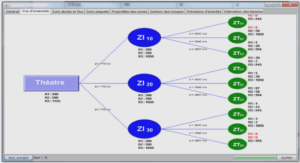Leaf economics and slow-fast adaptation across the geographic range of Arabidopsis thaliana
Life history strategies of most organisms are constrained by resource allocation patterns that follow a ‘slow-fast continuum’. It opposes slow growing and long-lived organisms with late investment in comparisons also impede a deep exploration of the linkage between LES variation and adaptation to climate. Here, we measured growth, morpho-physiological and life-history traits, at both the leaf and Arabidopsis thaliana. We found that the LES is tightly linked to variation in whole-plant functioning, and aligns with the slow-fast continuum. A genetic fast strategies in contrasted climates. Slow growing and long-lived plants were preferentially found in shed light on the role of the slow-fast continuum for plant adaptation to climate. More broadly, they encourage future studies to bridge functional ecology, genetics and evolutionary biology to improve our understanding of plant adaptation to environmental changes. #e slow-fast continuum is a pervasive trade-off between resource allocation to growth, reproduction and sur- vival, spread across the tree of life1. #e slow end of this continuum is characterized by slow growing, long-lived species and low reproductive output, while species at the fast end reach reproductive maturity faster and produce more offsprings. In plants, the leaf economics spectrum (LES herea$er)2–4 is thought to reflect the physiological basis of the slow-fast continuum4. #e LES arrays plant species along a continuum of leaf trait syndromes going from short-lived leaves with fast metabolism to the reverse syndrome3. Core LES traits include leaf dry mass per area (LMA), leaf lifespan (LLS) and net photosynthetic rate per mass unit (Amass)3,5–7. LES traits are widely used in comparative ecology to infer whole-plant ecological strategies4,8–12. However, the extent to which leaf-level resource economics reflects whole-plant physiology, performance, and ultimately fitness, is still under debate13. Many processes can lead to a mismatch between LES and whole-plant functioning14, including the impact of self-shading among leaves and resource allocation patterns, such as carbon investment in non-photosynthetic tis- sues15,16. To gain insights into the robustness of the slow-fast continuum at different organizational levels, we need .
#e LES has been associated with differences in the ability of plants to adapt to more or less harsh environmen- tal conditions4,12,20,21: species displaying high photosynthetic, respiration and growth rates, are short-lived, with thin and nitrogen-rich leaves are preferentially found in nutrient-rich and/or growth-suitable climatic conditions. #ose species are qualified as acquisitive species in contrast to conservative ones that exhibit the opposite set of traits. Despite these observations, functional ecology has no tools to test for adaptation, and empirical evidences of the adaptive value of being at one end or the other of the continuum in a given environment remain scarce (see ref.22 for a review). Furthermore, sampling procedure in field observation studies o$en impedes to disentangle the effects of plasticity vs. genetic differentiation on the emergence of the LES23. #us, comparative studies looking for plant adaptation are at best incomplete22–24, and the role of selection in shaping the LES and driving adaptation to diverse environments is hardly understood. To fill this gap, intraspecific studies are encouraged since they can take benefit from tools developed in population ecology and genetics22,25,26. #e LES has started to be analyzed at the intraspecific level, with contrasting findings depending on the studied organism and type of study23,27–32. LES relationships appeared consistent with cross-species ones when using species with broad environmental niche spectra31–33 and/or broad phenotypic variability23, but inconsistent when using species with narrow phenotypic (and genetic) diversity34. Genetic differentiation of LES strategies has been demonstrated among populations of Helianthus anomalus along a 400 km rainfall gradient35. However, the question whether LES diversifies because of adaptation to climate among lineages spanning large geographic distribution remains open. Overall, we still miss a comprehensive understanding of within-species LES variation and the subsequent insights they can provide to well-described interspecific patterns from an evolutionary perspective.





